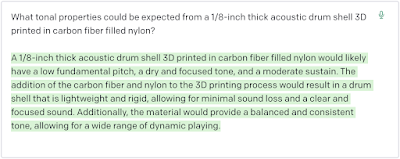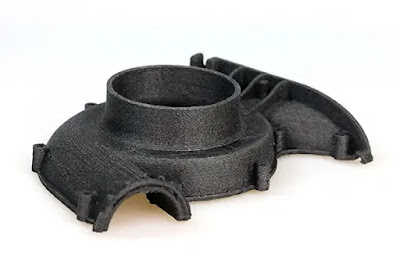A misadventure in 3D printing drums
My attempt to 3D print drums in nylon carbon fiber is foiled by high printing costs and Panic at the Disco.
By Darin Soll
Unfortunately, a brief patent search in 2017 revealed that the specific feature I felt would differentiate my 3D drum designs had already been patented decades before and was now in the public domain. At that time, it didn't occur to me to look into patenting the use of specific materials in 3D drum printing. Shortly after the patent search, I landed my next day gig, so I shelved my 3D drum printing dream and went back to work.
Designed with Nylon CF in mind, my prototype features a 1/8-inch thick shell stiffened by 30-degree roundover bearing edges. The integrated lugs have molded cavities to accommodate metal tension rod receivers.
While finalizing the design with my CAD freelancer, I launched a second patent search to see if there was an existing patent that covers 3D printed drum shells using nylon filled with carbon fiber.
By Darin Soll
Six years ago, I attended a local Design-2-Part trade show. I was interested in 3D printing, and I wanted to see the latest advancements in the technology. At that show, industrial 3D printer manufacturer Markforged was handing out samples printed in nylon filled with carbon fiber. Sold under trade names Onyx™, Nylon CF, and others, this material has properties similar to aluminum, but lighter.
I could barely flex a 3mm thick sample. It stopped me in my tracks--it was strong, dense, and rigid. The sample was charcoal in color with a texture that reminded me of powder coating. I immediately wondered whether this was the ultimate material for 3D printing drum shells.
I was between day jobs, so I spent a significant amount of time thinking about how I could build a business around 3D printed drums. To build a viable 3D drum printing business, I feel that patent protection is critical. 3D printing eliminates the need for a specialized factory, and copying and printing someone else's designs would be fairly easy to do. Patent protection would be the best way to ensure that a drum printing business is compensated for its investment into research and development, as well as any innovations that might result from that investment.
 |
| ChatGPT perspective on Nylon CF drum shells |
Fast forward to October 2022, when I finally decided to design and print a prototype 8x12 tom. The first step in this process was to create a 3D CAD design. I posted a job on Upwork and found a 3D CAD freelancer with an engineering background who quickly brought my sketches to life. My design had some complex geometry involving the bearing edges and integrated tension lugs, but the designer nailed it.
 |
| CAD design of drum shell for 3D printing |
While finalizing the design with my CAD freelancer, I launched a second patent search to see if there was an existing patent that covers 3D printed drum shells using nylon filled with carbon fiber.
Armed with my detailed 3D design, I then requested printing quotes from several major online 3D printing services. A couple of them ran my design through a slicer. A slicer analyzes the 3D design and breaks it down into specific instructions for the 3D printer. This analysis identified a few opportunities to optimize my design to reduce printing cost.
The bad news came in the form of a one-two punch. First, the Nylon CF 3D printing quotes all came back in the $4000-$8000 range. Ouch. Worse, my second patent search turned up a match. An active patent was granted in late 2019 to Daniel Pawlovich, the drummer for Panic at the Disco. His comprehensive patent, US 10,497,345 B2 (Dec. 3, 2019), covers most of the items I believed were unique to my design.
Being late to the patent party is a disappointment, but I applaud Dan for recognizing the potential of 3D printing for building drums! This YouTube video details his 3D printing journey. His 3D printing partner, Stratasys, also published a case study on Dan's 3D printed snare drums. I emailed Dan to see if he might be interested in a partnership. I would love to know what he plans to do with his patent.
I would also love to hear the tone of a tom drum 3D printed in Nylon CF! If the prices ever come down, I still plan to do a test print of my prototype drum design.
--Darin

 My attempt to 3D print drums in nylon carbon fiber is foiled by high printing costs and Panic at the Disco.
My attempt to 3D print drums in nylon carbon fiber is foiled by high printing costs and Panic at the Disco.











I've personally done quite a few shells testing out a variety of filaments for resonance. I've also done the lugs conventionally mounted but they are 3d printed. I found that the lugs themselves do not impact the tone as much as one would think. It's almost exclusively the bearing edge, hoop, and shell thickness.
ReplyDeletehttps://www.instagram.com/shattered_cycle_drums/
I have found that it's not the lugs themselves, but how the lugs are attached. Any type of stress on a shell, such as overtightened lug bolts, can choke the tone of the shell. Quality drums use some type of grommet that prevent lug bolts from loosening even at minimum tension. I've had drummers comment how hardware seems loose on DW and PDP drums. This is done on purpose to keep tension off of the shell.
ReplyDeleteI've experienced the same thing with solid tom mounts choking the tone of drums. Suspension mounts avoid the issue of overtightened solid tom mounts from choking the tone.